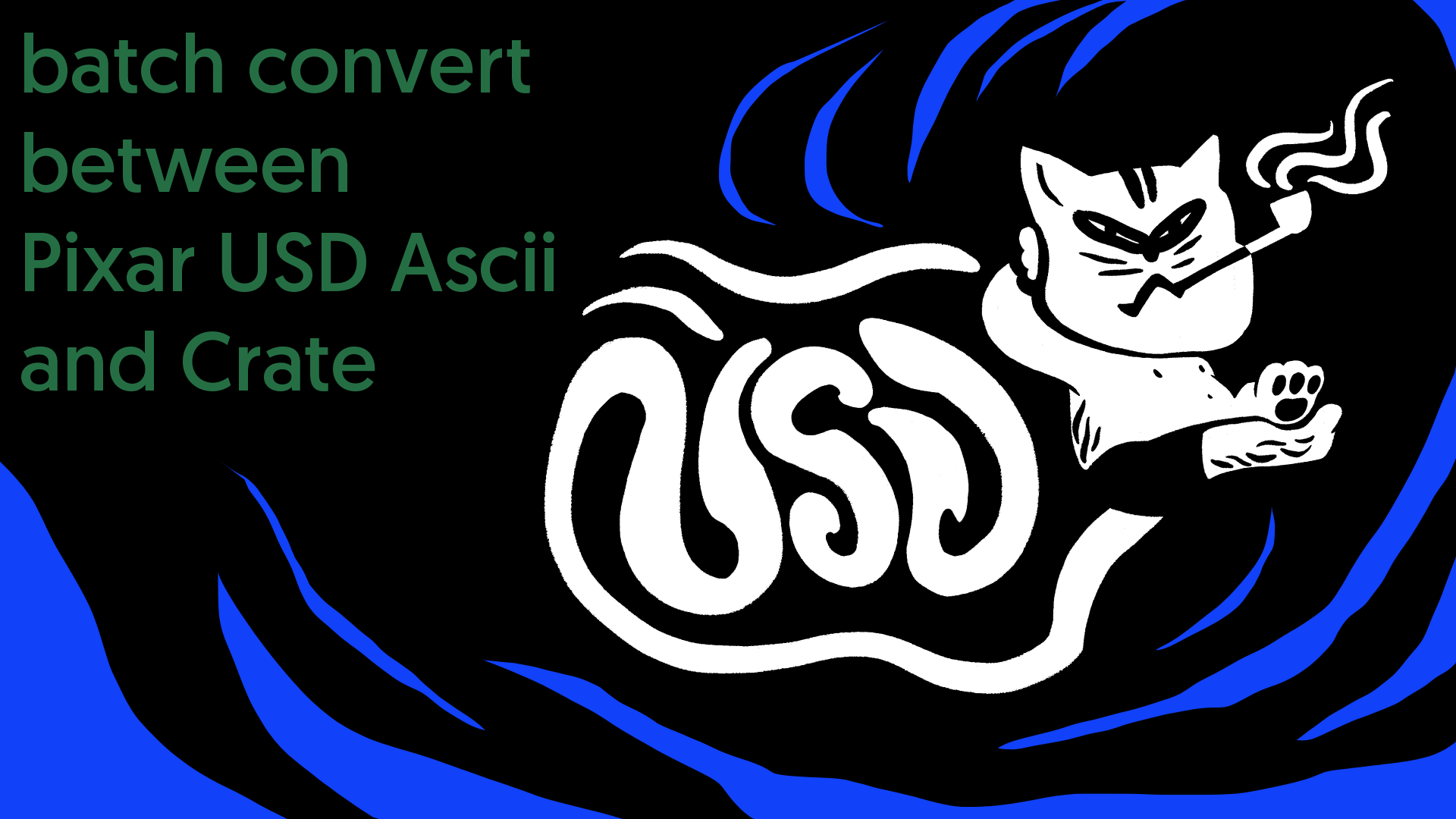
WHAT
This is a small, stand-alone, utility tool written in Python for Windows that allows you to batch convert between Pixar USD binary and ASCII formats. Under the hood it employs Houdini hython and the native USD support in Houdini Solaris, so Houdini 18 is required, and also at least an Indie license — in order to write out .usda file format.
A compiled .exe is also provided for ease of use.
WHY
Pixar USD is super exciting and powerful. And Houdini Solaris is, too! While learning USD, there are several very good, official, examples — the Kitchen set and Shopfront — either by Pixar or by SideFX, but unfortunately they are all provided in USD binary — thus obviously not human-readable — format (named the crate format). So in the process of learning, I found myself wanting to be able to decipher more how each part in those USD files contributes to the final scene composition. Of course one can always take advantage of the displayed USD scene graph either in usdview or in Solaris, or take advantage of the LOPs code in Solaris, but I believe the ability to read the .usda (as text file) would be extremely helpful and eye-opening.
Luckily Pixar already provides "usdcat" — an utility in their USD toolset — which allows for convenient conversion among .usda, .usdb, and .usdc formats. Just some small catches:
- We would want to convert multiple files. The kitchen example has 230 USD files. It's great that usdcat accepts multi-file input, but the idea of manually passing hundreds of file paths as command arguments sounds not so fun.
- Though very likely an outlier case and a rather subpar practice, in case you also want to change the file extensions during conversion, e.g. from .usdc to .usda and vice versa, then you would then also need to tweak the references in the USD file content in order to have the USD asset resolution working. For example, after our binary to ASCII conversion, all lines that have
"@/any_asset.usd@"in the resulted files must also be changed to"@/any_asset.usda@"
This poses a great opportunity for a simple batch conversion tool, hence our mk_usdcat_all!
HOW
The tool is very simple to use.
First take a look at the Prerequisites line edit in the UI and make sure the tool know where to look for hython and usdcat, both in the "bin" folder within your Houdini installation folder.
Most of the time you would want to perform usdcat in bulk. So drop the folder containing all the USD files to the second line edit (see below) to batch convert all USD files found within that folder. You can also copy and paste the link to that folder there. Then from that line edit press Enter to start the batch conversion process.
Hython will then summon usdcat to perform conversion between USD formats, file by file. This might take a while, firstly of course depending on how many USD files there are in the specified folder, and also how heavy they are, but secondly due to the fact that hython also needs to verify your Houdini license each time.
Behold! Below is a screengrab of the resulted Kitchen_set in ASCII:
After the conversion is complete with every USD file in the folder (you can tell by looking at the progress bar in the UI), you can use the wonderful usdview that is also shipped with Houdini Solaris to view and verify the results.
SOME BENCHMARKS
The Pixar Kitchen set with 230 USD files took about 730 seconds (~12 mins) to convert everything from crate format to ASCII. The project size increased to 32 MB from 5 MB.
I carried a test with a small project of mine using the Lion anatomy model by Maria Panfilova, in which I used Houdini PDG to generate >400 USD binary files — including all the payload, material, and assembly, files —. The project size before conversion was about 16 MB. The conversion took 1380 seconds (~23 mins), and the project size increased to 97 MB. After batch converting all 444 USD files using our usdcat tool, the whole project still works nicely without any issues.
KNOWN ISSUES
Using the .exe may spare you from all the Python environment setup, but hython command prompts will keep popping up throughout the batch conversion process, which rather makes it inconvenient to use your machine during that time.
FEEDBACK & SUGGESTIONS
If you have any feedback or suggestions, feel free to send me a message. Thanks!






COMMENTS
nilsoncardososa 4 years, 3 months ago |
Excellent, very useful
mushogenshin 4 years, 3 months ago |
Thanks, nilsoncardososa! Feel free to give me ideas for improvements. Cheers.
OdFotan 4 years, 3 months ago |
Thank u!
OdFotan 4 years, 3 months ago |
Can we convert this app to a Mac app?
My ignorant guess is since that since it is all Python it is cross-platform. Please help.
mushogenshin 4 years, 3 months ago |
Hi OdFotan, would you be able to pass arguments to the Python script manually, or would you still prefer a GUI? Cheers.
mushogenshin 4 years, 1 month ago |
Version with support for MacOS is live on the GitHub repo.
Cheers,
Please log in to leave a comment.